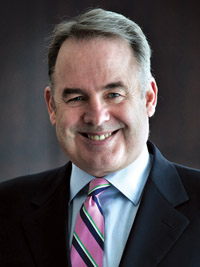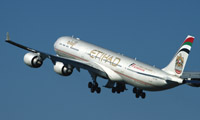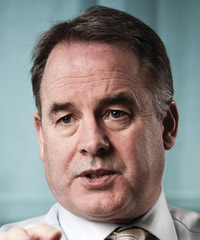Cover Story
GAME CHANGER
The president and chief executive of Abu Dhabi’s Etihad Airways, James Hogan, has a strategy that is turning the concept of airline-to-airline co-operation on its head. It is helping the fast-expanding, nine-year-old Gulf carrier extend its global reach in a rapidly changing aviation world.
February 1st 2013
Etihad Airways’ string of investments in partner airlines, with reports of more to come, has intrigued its competitors. Read More »
 |
| James Hogan President & CEO Etihad Airways |
But the airline’s Australian-born president and chief executive, James Hogan, is making no apologies for the millions of dollars spent securing stakes in carriers around the globe. “We are being very selective about who we invest in,” he said.
Hogan insists Etihad’s equity stakes are not about seeking control. “They are about cementing a partnership. Partnerships that will deliver growth in a constrained and challenged global landscape,” he said. In 2012, Etihad’s partnerships in the region delivered 20% of its total revenue, said Hogan.
Today, the Abu Dhabi-based operator, which was launched less than 10 years ago, has substantial equity in four airlines: Germany’s airberlin (29%), Air Seychelles (40%), Virgin Australia (10%) and Ireland’s Aer Lingus (2.9%). Hogan suggested more investments were a possibility.
However, when Orient Aviation interviewed the airline chief at his headquarters near Abu Dhabi’s international airport, he refused to confirm Etihad was in discussion with another potential offshore airline partner.
It has been widely reported that Etihad was in talks with India’s Jet Airways. Indeed, Jet told the Bombay Stock Exchange in a statement last month that “various structures are being explored by the legal and commercial teams”.
How long these discussions might take, and whether they would ultimately succeed, remained to be seen. Unconfirmed reports from Indian sources said a 24% stake in Jet was on the table for a sum in excess of US$300 million. Jet founder and 79.99% shareholder, Naresh Goyal, is known as a tough negotiator.
Etihad had a stellar year in 2012. It carried more than 10 million passengers, a 22% increase on its 8.41 million passengers in 2011. The airline took delivery of seven new aircraft, three A320s and four B777s, which increased its fleet to 71 aircraft. By 2017, Etihad expects to have 120 aircraft.
Six new routes were launched in 2012: Tripoli, Shanghai, Nairobi, Basra, Lagos and Ahmedabab. They increased Etihad’s global network to 87 passenger and cargo destinations, together with an additional 245 code-shares. This effectively gives Etihad more reach than United Arab Emirates neighbour, Emirates Airline, in Dubai.
 |
| Etihad Airways: has firm orders for 100 aircraft |
Etihad first flew in November 2003. Today, it has 10,000 employees, made up of 125 nationalities. The airline has 74% of all travellers passing through Abu Dhabi. With its equity partners, Etihad carries more than 74 million passengers.
Last year, Bangkok was the carrier’s busiest route with nearly 691,000 passengers, a 38% increase on 2011.
Etihad is making money at a time when many airlines around the world are struggling to maintain profitability.
“We earned $5 billion in revenues [for 2012],” said Hogan. At press time, it announced a profit of US$42 million for the 2012 year. In 2011, Etihad made a profit of $14 million.
This year also looks bright. Last month, Etihad launched direct flights to Amsterdam, its ninth European destination. Also scheduled for this year are three new global routes - Washington DC in March, Sao Paulo in June and Ho Chi Minh City in October.
Fourteen aircraft will join the fleet this year; four A320s, one A321, one A330 freighter, two B777 freighters and six B777-300ERs. The signs are that Etihad will not have any trouble filling the new planes. On January 5, it set a record for passengers carried across its worldwide network in a single day - 33,802.
The Gulf carrier has 100 aircraft on firm order, including 41 B787-9s, 12 A350-1000s and 10 A380s.
But what are the benefits of a cash stake for Etihad that it can’t get from a code-share or co-operative agreement?
Hogan is in no doubt. Scale. “A code-share is effectively about two things, network and frequent flyers. With equity investment you also have the ability to start looking at areas that include joint procurement, aircraft programmes and centres of excellence,” he said.
 |
| '[Equity stakes] are about cementing a partnership. Partnerships that will deliver growth in a constrained and challenged global landscape' |
| James Hogan |
“A year ago, we announced we would raise our stake in airberlin to 29%. Etihad has already recouped its initial investment of US$105 million,” he said.
“More than 300,000 additional passengers flowed into the networks of both airlines in 2012. That figure is set to increase considerably in 2013 as the impact of closer cooperation across almost every division of each carrier comes to fruition.”
The partner airlines have also announced they will integrate their B787 Dreamliner programmes which will incorporate 56 aircraft. Millions of dollars will be saved by sharing infrastructure, pooling maintenance, developing joint training programmes and streamlining purchasing for engines, rotables, avionics and inflight entertainment systems.
Aircraft utilization has become critical for increased efficiency among the partners. “We’re starting to use their metal to fill gaps or take advantage of aircraft sitting on the tarmac. So, with Virgin Australia, which flies to Abu Dhabi three times a week, we use the ground time to do a Kuala Lumpur rotation. We wet-lease their B777 and it operates to Malaysia and back with their crew,” said Hogan.
There is a similar arrangement with Air Seychelles, which now hubs through Abu Dhabi and next month will begin flying on to Hong Kong on behalf of Etihad, helping develop the China market. Airberlin flies to the Gulf from Dusseldorf and Berlin, then on to Phuket in Thailand waving the Etihad flag.
More cost savings have been achieved through rebates on information technology systems through joint deals with Sabre, as well as on engine purchases.
“Airberlin took GE engines for their B787s on the back of our deal, a deal they would never have got because it’s another 15 aircraft. It also gave us a further benefit. We are all getting considerable advantage of scale in unit cost reduction,” said Hogan.
Etihad has been able to centralize some of the operations of its partners, eliminating duplication and, again, fostering big savings.
Air Seychelles, he pointed out, lost $25 million in 2011, but will break even for 2012. The airline reduced staff numbers by 400. Its revenue management, pilot and cabin crew training were all moved to Abu Dhabi. Etihad is extending its simulator centre and airberlin will train its B777 pilots there. “We are creating centres of excellence,” said the Etihad boss.
In December, Etihad acquired 70% of the airberlin topbonus frequent flyer programme for more than $260 million. “That’s step one of setting up a separate company, which will initially manage the Air Seychelles, Etihad and airberlin programmes,” said Hogan. It is expected the new company could eventually manage the frequent flyer schemes of all the partner airlines.
He said the acquisition is part of a strategic evolution to create a “house of brands” loyalty management company with global scale. “The loyalty programme sector is a faster growing and higher margin business than the airline industry,” said Hogan. “The new company provides an attractive vehicle for other airlines looking to generate further revenues from the fast-growing loyalty management sector.”
Etihad’s strategic direction is occurring at a time of industry change.
Once regarded as “stand alone” operators who eschewed alliance membership, the Gulf carriers have all shifted direction. Doha-based Qatar Airways is joining oneworld. Emirates has forged a major partnership with Qantas Airways.
“What is common to all of us is that the more we spotlight the Gulf as a transfer point, the more good it does us. That’s where it stops though. We all have our own targets and we have different strategies,” said Hogan.
“We are obviously the smaller of the three carriers. We won’t join one of the alliances. We will stay non-aligned as it gives us scale from a network perspective.
“We are seeing differing strategies for Qatar and Emirates. But all three can survive. What we are seeing is a Gulf crossroad, like the Asia crossroad in the 1970s and 1980s, especially Singapore: a global city, small population, but growing a first class airline. That’s what we are doing.”
It is part of Etihad’s strategy of tackling a changing aviation world, he added. “People outside the Gulf forget that within three hours flying time from Abu Dhabi we have the GCC [Gulf Co-operation Council countries], the Middle East and the Indian subcontinent and that’s a market the size of China,” said Hogan.
But not everything is perfect. “It’s a market that is heavily regulated, a market that is bilaterally constrained, but it’s a market where people are travelling and that is our home market. When you start putting all these things together, we are very bullish about the way forward with our strategy,” he added.
Hogan knows there will be problems ahead. He said the global economic crisis had changed economies, industries and businesses. “We have all felt its impact. We’ve all had to react to new economic realities,” he said.
Etihad operates in a fragile part of the world. “We face issues running airlines every year, whether it’s a volcano or tsunami or the Arab Spring. You’ve got to be flexible to adjust and we are adjusting to differing times,” said Hogan.
“Any airline CEO has to keep a firm focus on economic and political factors outside your control. For example, we were one of the first carriers to come out of Damascus [Syria]. The flip side is that Australia is doing well. Southeast Asia and the Americas are doing well.
“We go into South America this year. We will be flying to six continents so how we balance our network and work with partners is vital. You never know what is round the corner.”
As for India, Hogan left no doubt the partnership scenario was on his agenda.
“It’s a huge market,” he said. “Some 40 million Indians travel a year and that’s growing at 10% per annum. Around 2.6 million a year go to the U.S. and 4.8 million go to Europe,” he said.
“The Gulf and India has a historical relationship that goes back centuries. There’s a big Indian population here.” It would be hard for Etihad to ignore that.